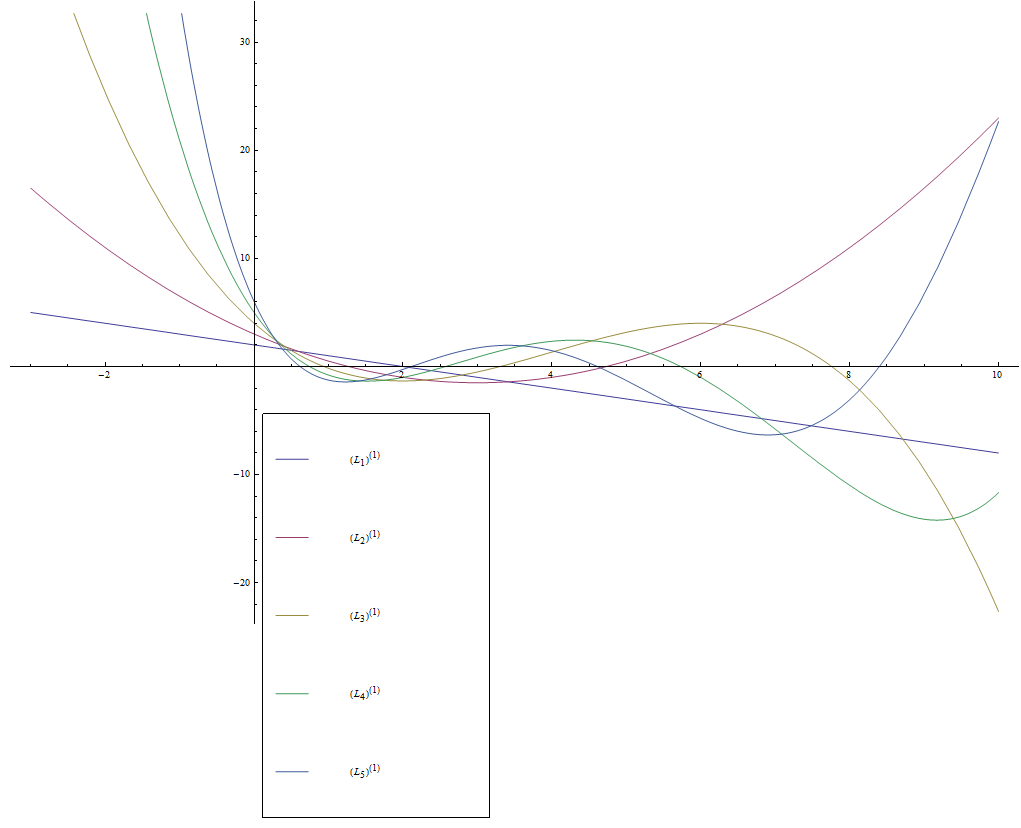Difference between revisions of "Associated Laguerre L"
| Line 1: | Line 1: | ||
| − | Let $\ | + | Let $\lambda \in \mathbb{R}$. The associated Laguerre polynomials, $L_n^{(\lambda)}(x)$ are solutions of the differential equation |
| − | $$x\dfrac{d^2y}{dx^2} + (1-x)\dfrac{dy}{dx} + ny=0.$$ | + | $$x\dfrac{d^2y}{dx^2} + (\lambda+1-x)\dfrac{dy}{dx} + ny=0.$$ |
The first few Laguerre polynomials are given by | The first few Laguerre polynomials are given by | ||
$$\begin{array}{ll} | $$\begin{array}{ll} | ||
| − | L_0^{(\ | + | L_0^{(\lambda)}(x) &= 1 \\ |
| − | L_1^{(\ | + | L_1^{(\lambda)}(x) &= -x+\lambda+1 \\ |
| − | L_2^{(\ | + | L_2^{(\lambda)}(x) &= \dfrac{x^2}{2} -(\lambda+2)x+\dfrac{(\lambda+2)(\lambda+1)}{2} \\ |
| − | L_3^{(\ | + | L_3^{(\lambda)}(x) &= -\dfrac{x^3}{6} + \dfrac{(\lambda+3)x^2}{2} - \dfrac{(\lambda+2)(\lambda+3)x}{2} + \dfrac{(\lambda+1)(\lambda+2)(\lambda+3)}{6} \\ |
\vdots | \vdots | ||
\end{array}$$ | \end{array}$$ | ||
| Line 16: | Line 16: | ||
<div class="toccolours mw-collapsible mw-collapsed" style="width:800px"> | <div class="toccolours mw-collapsible mw-collapsed" style="width:800px"> | ||
<strong>Theorem:</strong> The following formula holds: | <strong>Theorem:</strong> The following formula holds: | ||
| − | $$L_n^{(\ | + | $$L_n^{(\lambda)}(x) = \displaystyle\sum_{k=0}^n (-1)^k {n+\lambda \choose n-k} \dfrac{x^k}{k!}.$$ |
<div class="mw-collapsible-content"> | <div class="mw-collapsible-content"> | ||
<strong>Proof:</strong> █ | <strong>Proof:</strong> █ | ||
| Line 24: | Line 24: | ||
<div class="toccolours mw-collapsible mw-collapsed" style="width:800px"> | <div class="toccolours mw-collapsible mw-collapsed" style="width:800px"> | ||
<strong>Theorem:</strong> The following formula holds: | <strong>Theorem:</strong> The following formula holds: | ||
| − | $$L_n^{(\ | + | $$L_n^{(\lambda+\beta+1)}(x+y) = \displaystyle\sum_{k=0}^n L_k^{(\lambda)}(x)L_{n-k}^{(\beta)}(x).$$ |
<div class="mw-collapsible-content"> | <div class="mw-collapsible-content"> | ||
<strong>Proof:</strong> █ | <strong>Proof:</strong> █ | ||
| Line 32: | Line 32: | ||
<div class="toccolours mw-collapsible mw-collapsed" style="width:800px"> | <div class="toccolours mw-collapsible mw-collapsed" style="width:800px"> | ||
<strong>Theorem:</strong> The following formula holds: | <strong>Theorem:</strong> The following formula holds: | ||
| − | $$L_n^{(\ | + | $$L_n^{(\lambda)}(x) = L_n^{(\lambda+1)}(x)-L_{n-1}^{(\lambda+1)}(x).$$ |
<div class="mw-collapsible-content"> | <div class="mw-collapsible-content"> | ||
<strong>Proof:</strong> █ | <strong>Proof:</strong> █ | ||
| Line 40: | Line 40: | ||
<div class="toccolours mw-collapsible mw-collapsed" style="width:800px"> | <div class="toccolours mw-collapsible mw-collapsed" style="width:800px"> | ||
<strong>Theorem:</strong> The following formula holds: | <strong>Theorem:</strong> The following formula holds: | ||
| − | $$nL_n^{(\ | + | $$nL_n^{(\lambda+1)}(x) = (n-x)L_{n-1}^{(\lambda+1)}(x)-(n+\lambda)L_{n-1}^{(\lambda)}(x).$$ |
<div class="mw-collapsible-content"> | <div class="mw-collapsible-content"> | ||
<strong>Proof:</strong> █ | <strong>Proof:</strong> █ | ||
| Line 48: | Line 48: | ||
<div class="toccolours mw-collapsible mw-collapsed" style="width:800px"> | <div class="toccolours mw-collapsible mw-collapsed" style="width:800px"> | ||
<strong>Theorem:</strong> The following formula holds: | <strong>Theorem:</strong> The following formula holds: | ||
| − | $$xL_n^{(\ | + | $$xL_n^{(\lambda+1)}(x)= (n+\lambda)L_{n-1}^{(\lambda)}(x)-(n-x)L_n^{(\lambda)}(x).$$ |
<div class="mw-collapsible-content"> | <div class="mw-collapsible-content"> | ||
<strong>Proof:</strong> █ | <strong>Proof:</strong> █ | ||
| Line 56: | Line 56: | ||
<div class="toccolours mw-collapsible mw-collapsed" style="width:800px"> | <div class="toccolours mw-collapsible mw-collapsed" style="width:800px"> | ||
<strong>Theorem:</strong> The following formula holds: | <strong>Theorem:</strong> The following formula holds: | ||
| − | $$\dfrac{d^k}{dx^k} L_n^{(\ | + | $$\dfrac{d^k}{dx^k} L_n^{(\lambda)}(x) = (-1)^kL_{n-k}^{(\lambda+k)}(x).$$ |
<div class="mw-collapsible-content"> | <div class="mw-collapsible-content"> | ||
<strong>Proof:</strong> █ | <strong>Proof:</strong> █ | ||
</div> | </div> | ||
</div> | </div> | ||
Revision as of 03:40, 25 October 2014
Let $\lambda \in \mathbb{R}$. The associated Laguerre polynomials, $L_n^{(\lambda)}(x)$ are solutions of the differential equation $$x\dfrac{d^2y}{dx^2} + (\lambda+1-x)\dfrac{dy}{dx} + ny=0.$$
The first few Laguerre polynomials are given by $$\begin{array}{ll} L_0^{(\lambda)}(x) &= 1 \\ L_1^{(\lambda)}(x) &= -x+\lambda+1 \\ L_2^{(\lambda)}(x) &= \dfrac{x^2}{2} -(\lambda+2)x+\dfrac{(\lambda+2)(\lambda+1)}{2} \\ L_3^{(\lambda)}(x) &= -\dfrac{x^3}{6} + \dfrac{(\lambda+3)x^2}{2} - \dfrac{(\lambda+2)(\lambda+3)x}{2} + \dfrac{(\lambda+1)(\lambda+2)(\lambda+3)}{6} \\ \vdots \end{array}$$
Properties
Theorem: The following formula holds: $$L_n^{(\lambda)}(x) = \displaystyle\sum_{k=0}^n (-1)^k {n+\lambda \choose n-k} \dfrac{x^k}{k!}.$$
Proof: █
Theorem: The following formula holds: $$L_n^{(\lambda+\beta+1)}(x+y) = \displaystyle\sum_{k=0}^n L_k^{(\lambda)}(x)L_{n-k}^{(\beta)}(x).$$
Proof: █
Theorem: The following formula holds: $$L_n^{(\lambda)}(x) = L_n^{(\lambda+1)}(x)-L_{n-1}^{(\lambda+1)}(x).$$
Proof: █
Theorem: The following formula holds: $$nL_n^{(\lambda+1)}(x) = (n-x)L_{n-1}^{(\lambda+1)}(x)-(n+\lambda)L_{n-1}^{(\lambda)}(x).$$
Proof: █
Theorem: The following formula holds: $$xL_n^{(\lambda+1)}(x)= (n+\lambda)L_{n-1}^{(\lambda)}(x)-(n-x)L_n^{(\lambda)}(x).$$
Proof: █
Theorem: The following formula holds: $$\dfrac{d^k}{dx^k} L_n^{(\lambda)}(x) = (-1)^kL_{n-k}^{(\lambda+k)}(x).$$
Proof: █
